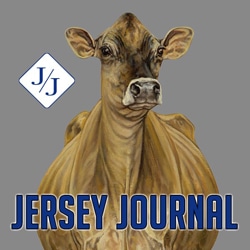Six Tips to Manage Dehydration in Jersey Calves
You’ve heard it before, and you’ll hear it again, calves are the future of your dairy farm. Keeping them healthy throughout the first few months of life sets them up for success as a milking cow in the herd. While each farm is unique, almost all farms have scouring calves. When the percentage of scouring gets too high or the scours are severe, calves are more likely to develop a respiratory disease that can affect them in maturity.

Scott Bascom, a Dairy Technology Manager with Phibro Animal Health (pictured left) provided six tips to manage dehydration in calves. Bascom was also a PhD student at Virginia Tech with Dr. Bob James and focused his research on managing Jersey calves. Spring is here and temperature fluctuations cause stress, making calves more susceptible to dehydration. Soon, the warm temperature of summer will be here, requiring more fresh water in front of calves. Bascom mentioned these tips to keep calves hydrated year-round.
1. Start off with adequate nutrition for your calves.
“Smaller calves use more calories to maintain their body temperature since they lose more body heat than bigger calves. We especially see that in winter with Jersey calves, however the same concept also applies with a smaller Holstein calf,” said Bascom. In his research, whole Jersey milk was the most successful nutrition plan followed by a higher fat and protein milk replacer to meet the energy needs of a smaller calf.
2. Feed one quart of electrolytes every day up to 10 days old.
“We were having problems with Jersey calves that we were using for our milk replacer study scouring badly and getting sick. We connected with vets that specialize in calves and they recommended this protocol, and our calves were immediately healthier,” stated Bascom. This gets calves through the critical point when most will scour, helping to prevent dehydration rather than treat it.
3. Find an economical and palatable electrolyte.
“The most important part of this dehydration prevention protocol is that the calves want to drink the electrolytes, they need to be palatable,” said Bascom. He mentioned that you should be able to feed electrolytes for less than $0.50 per calf. They fed electrolytes in an open bucket. When choosing an electrolyte to treat dehydration, Bascom recommends working with your veterinarian to use additional criteria to pick the right electrolyte.
4. Use a four-point fecal scoring system.
“After 10 days we used a four-point fecal scoring system and based treatment off the score,” said Bascom.
-
-
- Score 1- No treatment.
- Score 2- We added a feeding of one quart of electrolytes and continued for one or two days after the calf returned to a normal fecal score.
- Score 3- We added two feedings of one quart of electrolytes for one to two days after the calf returned to a normal fecal score.
- Score 4- Consult your veterinarian.Looking for a resource to help health score calves? Check out UW-Madison’s Calf Health Scoring Chart which features photos and a table to assist with keeping scoring consistent and accurate.
-
5. Make sure calves have access to fresh, clean water.
“Two days prior to seeing any signs of diarrhea we noticed the calves started drinking more water,” mentioned Bascom. If calves have water that is changed out daily, they will be more inclined to drink it and re-hydrate better.
6. Do what works for your farm.
“When we were studying management of Jersey calves across the country, some breeders ran low mortality rates while bypassing conventional wisdom for feeding Holstein calves,” said Bascom. If your management practices are keeping calves healthy, stick with it.
“The key in our success with calves in our research trial was that we went from treating dehydration to a program that prevents dehydration,” pointed out Bascom. If you get to the point of needing to treat scours, make sure to follow your farm’s veterinarian’s recommendations. Better genetics in the next generation of animals on your farm paired with healthy, hydrated calves is a key part of ensuring your milking herd continues to improve.
This article was contributed by AJCA-NAJ area representative Sydney Endres. Credit for the cover photo goes to Laura Moss, Cottage Grove, Tenn.




